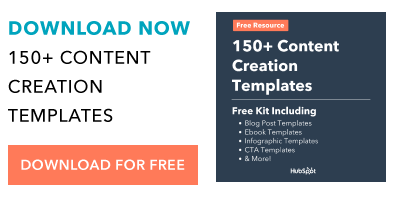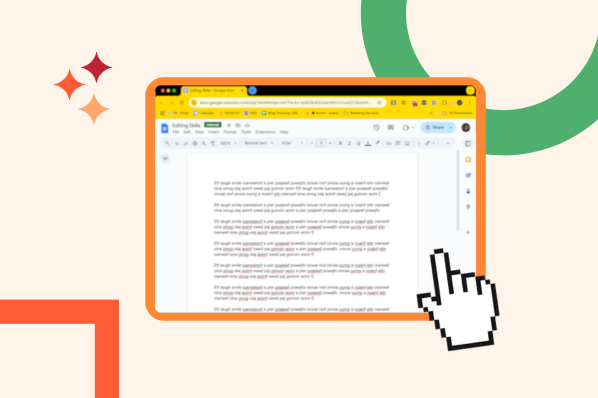I know what you're thinking: How can we offer free blog post content and then put the same content behind a form and expect that people will still be interested in downloading it? Let me explain.
First off, you may be using multiple blog posts to create an ebook. After all, ebooks are much longer and more detailed than blog posts. So now, instead of having your visitors read 5-10 different blog posts on a topic that are across your entire blog, you're now giving them all of the content in one place with a cohesive narrative.
Second, you're still adding more information and context when you create an ebook. Blog posts have detail, but they often can't include all of the intricate information and examples that can be incorporated in an ebook. With ebooks, it's your time to go crazy and add the color that makes gated content worth the read!
So let's go through the process of turning your next blog post (or next few blog posts) into an informative, marketable ebook that can provide real use for your audience.
Step 1: Test a subject by writing a blog post about it.
Sometimes, it can be hard to predict what piece of content will perform well and what will tank. Writing an ebook takes a ton of time and resources and may not be worth it if the content isn't compelling to your readers. So it makes sense to write a blog post on a specific subject first to see how the content performs.
Sure, a blog post takes time to write, but it's not as big of an investment as an ebook. If the post performs well, you'll know it's worthwhile to invest in writing an ebook on the same subject. If it doesn't perform well, it'll be a clear sign you ought to move on to another topic.
For the sake of this post, we'll use this past Inbound Hub article that performed well as our main example of one we could transform into an ebook: "The 16 Most Important Social Media Updates of 2012."
Step 2: If it performs well, find other past content written about it.
So now you've tested out your content. It performed well (awesome!), and you're ready to write a lengthy ebook about the topic. Your next step is to look back at some of the other blog posts you've written in the past to see if you've touched on the subject before.
For example, if you wanted to write an ebook about email marketing, you should look back and find everything you wrote about the subject in recent months. Sure, there may be some things that are outdated, but there will likely be some parts of old posts that stay relevant and can therefore be used in your ebook.
Let's follow the same example from before. You may have noticed that we have created a lot of content around writing blog posts (appropriate, right?). Here are some other blog posts we used to help create an offer:
- "Facebook Launches Global Pages to Simplify Brands' International Facebook Presence"
- "Twitter Launches Tailored Trends, Making Newsjacking Even Easier"
- "LinkedIn Launches New Company Page Design: See What's Changing"
Step 3: Use the different facets of your blog posts as chapters of your ebook.
In this next step, it's time to focus on the main chapters of your ebook, not the introduction or conclusion.
Take a look at the different blog posts you have compiled. Using what you've gathered, consider what chapters you could make for your ebook. For instance, one blog post could make up an entire chapter or you can combine different parts of blog posts to create your chapters.
Check out the ebook we ended up making from the social updates blog post called "21 Social Media Updates & Advancements to Inspire Your 2013 Strategy" as a premier example. Each chapter is a section of the blog post, just fleshed out a little more.
Step 4: Update the content.
After you decide what you want your chapters to be about, make sure to update the content accordingly.
Some of the information you use as the basis for chapters may be a few months (or even years) old. As we all know, relevancy of content changes very fast and may to be modernized as you're refreshing your content. Thus, if a piece of content from a blog post isn't relevant anymore, make sure to update it when you are writing your ebook.
For example, in June, HubSpot posted an article about Twitter and LinkedIn's break-up called "Twitter & LinkedIn Break Up, Disabling Automatic Posting of Tweets." In the past, we had posted content that referenced the ability to sync tweets to publish on LinkedIn. However, when publishing the new ebook about social media updates and advancements, we had to make sure we did not reference the ability to publish tweets on LinkedIn.
Step 5: Make the content meatier.
The beautiful thing about ebooks is that you have the luxury of adding more detail than blog posts. Take your blog post content and see if you can find examples of companies using the tactic you described.
It's imperative, though, that you use more detail to describe the information you wrote about in your blog post. And if there's applicable data to the subject at hand, make sure to include that in your ebook (you can always cut out excess info and stats if needed once the content is complete).
In our particular ebook, we found five more social media updates that had been made throughout the year and added them to the content of the blog post (which initially only included 16 updates).
Step 6: Write the introduction and conclusion.
When you start working on the intro, you want to set up the topic clearly and grab (and maintain) the readers' attention so they're convinced this piece of content is exactly what they're looking for. The best way to do this? Explain what makes your ebook valuable right upfront.
In the conclusion, give your reader an action item. What should they do now that they have read your ebook? Is there another place they can go to get additional information? Is there another resource that your company has created that can help them out?
Step 7: Design your ebook.
After your introduction, body, and conclusion are completed, you can start designing your ebook. You don't have to do anything too fancy or fill every single white space with infographics and images. Keep it simple, and make sure you're not deterring away from the content.
Need some ideas as to how to appropriately design your ebook? This blog post features expert advice that can ensure your ebook looks great, provides a quality user experience, and gets your point across perfectly.
Step 8: Make the finishing touches.
You're almost there! It's now time to put on the final touches for your ebook. Make sure you copyedit to catch all of your grammatical and spelling errors. Also, add some calls-to-action to tell your visitors what they should do after they finish reading the ebook. And last but not least, make sure to promote your ebook to your audience! After all, they likely won't read it if they don't know it exists!
What other steps do you take when repurposing content?
Content Creation



![12 ebook templates for InDesign, PowerPoint, and Google Docs [free download]](https://53.fs1.hubspotusercontent-na1.net/hubfs/53/free-ebook-templates-1-20240529-4957105.webp)




![How to Create an Ebook From Start to Finish [Free Ebook Templates]](https://53.fs1.hubspotusercontent-na1.net/hubfs/53/how-to-create-an-ebook-1-20250128-3015373.webp)
![How to Write a Content Brief [Template + Examples]](https://53.fs1.hubspotusercontent-na1.net/hubfs/53/content-brief-1-20250120-7521165.webp)


